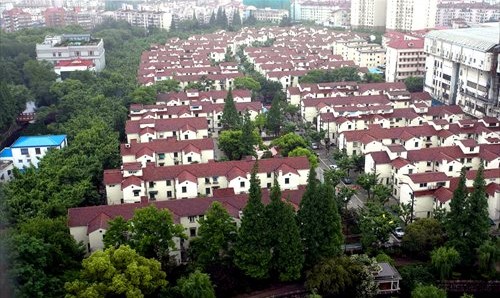 |
| The first phase of Caoyang New Village, one of the first socialist workers' villages in China, was completed in May 1952. Photo: Yang Hui/GT |
"For me, the Caoyang New Workers' Village means my grandmother's home, the address on my birth certificate, the playground on Lanxi Road and all the best and worst things in my childhood." Zhang Qiwei recalls his upbringing in one of the city's most significant housing projects in the 1950s.
To solve the severe accommodation shortages for Shanghai's 3 million workers after the city's liberation in 1951, the Shanghai Municipal People's Government set up the Shanghai Workers Housing Construction Committee. Pan Hannian, a former vice mayor of Shanghai, was in charge of the construction of the workers' villages.
This workers' village was sited north of Zhongshan Road North and to the west of Caoyang Road. Although it was on the outskirts of Shanghai at that time, it was not far from the factory districts of Changning, Putuo and Zhabei.
In September 1951, the first phase of the village project was launched and it was completed in May 1952. This is what is today known as the first Caoyang New Village. The 48 buildings spread over 13.3 hectares and 1,002 families quickly moved in to the first socialist workers' village in China.
After that construction began on several other worker accommodation projects like the next eight Caoyang New Villages which were built in the eastern and western industrial areas of Shanghai in Putuo and Yangpu districts. Many of Shanghai's model workers moved into these new villages. Zhang Qiwei's grandmother Fang Linzhen was allocated an apartment in the fifth Caoyang New Village in 1954.
Zhang Qiwei.

 Luxury-cars parade held in Dubai
Luxury-cars parade held in Dubai Special forces take tough training sessions
Special forces take tough training sessions Fire guts 22-storey Nigeria commercial building in Lagos
Fire guts 22-storey Nigeria commercial building in Lagos Singles Day:
Singles Day:  Temperature drops dramatically in Beijing
Temperature drops dramatically in Beijing Typhoon Haiyan hits south China's Hainan
Typhoon Haiyan hits south China's Hainan Top 10 celebrity moms in China
Top 10 celebrity moms in China Weekly Sports Photos:
Weekly Sports Photos: Gingko leaves turn brilliant golden yellow in Beijing
Gingko leaves turn brilliant golden yellow in Beijing Maritime counter-terrorism drill
Maritime counter-terrorism drill Love searching stories in cities
Love searching stories in cities Male belly dancer in women’s fitness club
Male belly dancer in women’s fitness club  15 best rivers for travelers in world
15 best rivers for travelers in world National Geographic Traveler Photo Contest
National Geographic Traveler Photo Contest Weekly Sports Photos
Weekly Sports PhotosDay|Week|Month